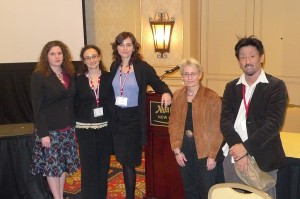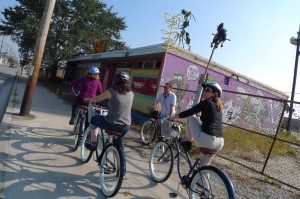
Difficult Knowledge in New Orleans
New Orleans is a fantastic place. I was very excited to head there for this year’s American Anthropological Association meeting to take part in the Curating Difficult Knowledge: New Models of Cultural Evocation and Intervention panel organized by CEREV director, Erica Lehrer. Minutes before landing, the view of Lake Pontchartrain, a massive body of water crossed by an impossibly long road, triggered images of the storm inside my head. Hurricane warnings, strong winds shaking palm trees, copious rain, endless lines of cars leaving town, the mighty hurricane sweeping by, levees breaking, water taking over the city’s lowlands, a gigantic stadium as a deficient shelter, people’s belongings floating in the water, people left behind to die… As we approached New Orleans from the air, the thought of Katrina as a social disaster felt more poignant than ever before.
Although most of the conference talks, including our panel, had little to do with the city itself, the question Erica posed in her opening remarks seemed particularly apt for thinking about what Katrina—its media coverage, its racial politics, and its still unfolding aftermath—brought up for American society: “What happens when the invisible is made visible, when knowledge relegated to society’s margins or swept under its carpet is suddenly inserted into the public domain?”
Our individual papers[1] offered considerations of projects that use curatorial/artistic strategies to deal with knowledge produced in and about the aftermath of violence: on-site and online exhibits, a documentary film and its reverberations for both the filmmakers and the interviewees, an ongoing series of public dialogues prompted by video documentary screenings, and a museum idea in the making. After the presentations, our panel discussant, professor Corinne A. Kratz (Emory University), provided thoughtful commentary and a number of critical questions that unfolded into a very productive conversation.
From among her many insightful remarks, I’d like to quote a couple of passages that point to the fruitful intersection of cultural analysis and curatorial work:
“Artistic practice includes approaches that fabricate unexpected encounters and images, and in the process both bring to awareness certain assumptions, taken-for-granted categories and narratives, and bring out overlooked perspectives and experiences. Artistic approaches are also a way to work with the emotional depth that can be involved in “difficult knowledge,” the ineffable nature of profound experience, and as a way to shape the context and mood of a space and occasion.”
Listening to my fellow presenters and our discussant, I was reminded of why being there (in the field) to learn from them (the people who live/ are there on daily basis) is as important as going back and sharing what we have learned in order to keep thinking with them. And it is in this bringing back through curatorial/ artistic strategies that new possibilities emerge at both the experiential and intellectual level for both the analyst and the participants. As Kratz put it:
“For all these projects, testimony, voices and perspectives are a major part of what is curated in producing a setting and display of some sort. But they curate and create conversations as well – again, curating responses after creating situations. […] In each case, contending, irreconcilable or at least alternative perspectives and statements help foreground the foundational “difficulty” of the situation and knowledge. And – perhaps – by giving name, shape and substance to the different stances, they may start to blur (as commonalities emerge or diverse opinions and memories emerge within groups).
I think this is basic to the sense of curation as intervention, as well as presentation and representation. Central to this […] is also an understanding of curation as an immersive social process. This is where the ethnographic connection comes in, in terms of what kinds of engagement and knowledge production are involved and their relatively open-ended approaches.”
This, I thought to myself while listening to professor Kratz in that fancy conference room, this is why I am an ethnographer. To be immersed and engaged in open-ended relationships with the communities I participate in.
Post by Florencia Marchetti
BACK 1. By CEREV postdoctoral fellow Monica Patterson, CEREV director Erica Lehrer, independent artist Shinpei Takeda, and CEREV doctoral student Florencia Marchetti. Panel abstract here.




